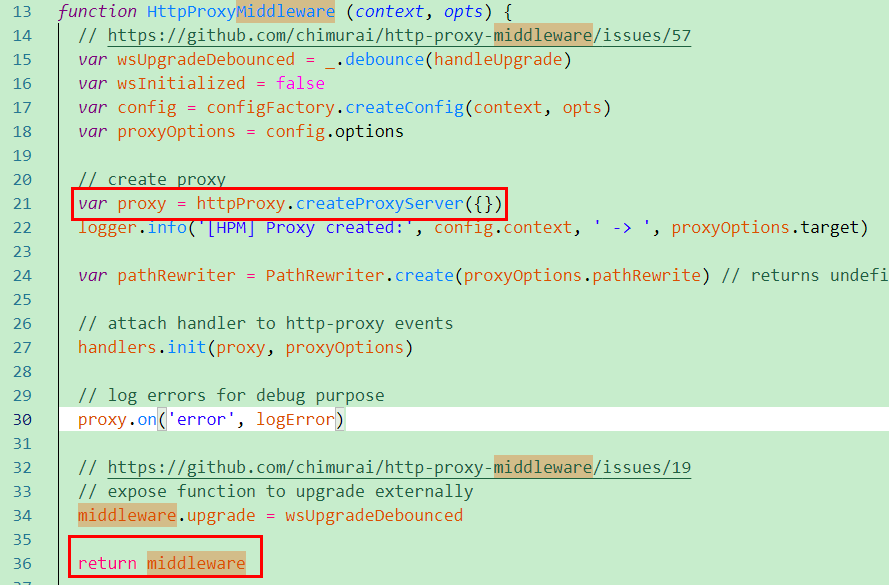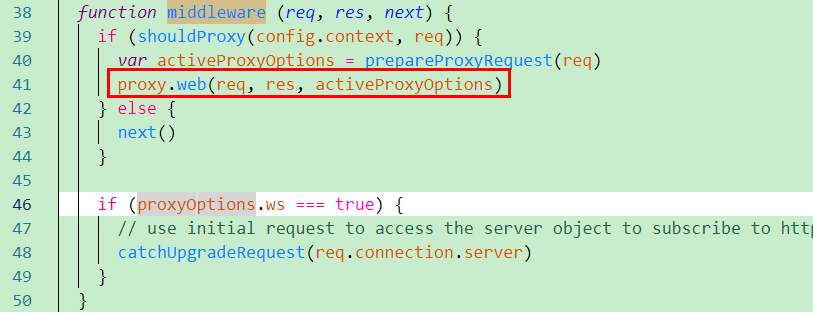本文主要讲http-proxy-middleware用法和实现原理。
一 简介
http-proxy-middleware用于后台将请求转发给其它服务器。
例如:我们当前主机A为http://localhost:3000/,现在浏览器发送一个请求,请求接口/api,这个请求的数据在另外一台服务器B上(http://10.119.168.87:4000),这时,就可通过在A主机设置代理,直接将请求发送给B主机。
简单实现代码如下:
1 var express = require('express'); 2 var proxy = require('http-proxy-middleware'); 3 4 var app = express(); 5 6 app.use('/api', proxy({target: 'http://10.119.168.87:4000', changeOrigin: true})); 7 app.listen(3000);
说明:我们利用express在3000端口启动了一个小型的服务器,利用了app.use('/api', proxy({target: 'http://10.119.168.87:4000/', changeOrigin: true}))这句话,使发到3000端口的/api请求转发到了4000端口。即请求http://localhost:3000/api相当于请求http://10.119.168.87:4000/api。
二 安装
1 $ npm install --save-dev http-proxy-middleware
三 用法和接口说明
proxy([context,] config)
1 var proxy = require('http-proxy-middleware'); 2 3 var apiProxy = proxy('/api', {target: 'http://www.example.org'}); 4 // \____/ \_____________________________/ 5 // | | 6 // 需要转发的请求 目标服务器
说明:第一个参数是可以省略的。
下边示例是用Express构建的服务器中用法:
1 // 引用依赖 2 var express = require('express'); 3 var proxy = require('http-proxy-middleware'); 4 5 // proxy 中间件的选择项 6 var options = { 7 target: 'http://www.example.org', // 目标服务器 host 8 changeOrigin: true, // 默认false,是否需要改变原始主机头为目标URL 9 ws: true, // 是否代理websockets 10 pathRewrite: { 11 '^/api/old-path' : '/api/new-path', // 重写请求,比如我们源访问的是api/old-path,那么请求会被解析为/api/new-path 12 '^/api/remove/path' : '/path' // 同上 13 }, 14 router: { 15 // 如果请求主机 == 'dev.localhost:3000', 16 // 重写目标服务器 'http://www.example.org' 为 'http://localhost:8000' 17 'dev.localhost:3000' : 'http://localhost:8000' 18 } 19 }; 20 21 // 创建代理 22 var exampleProxy = proxy(options); 23 24 // 使用代理 25 var app = express(); 26 app.use('/api', exampleProxy); 27 app.listen(3000);
3.1 参数一[context]详解
下边是一个完整地址划分:
foo://example.com:8042/over/there?name=ferret#nose
\_/ \______________/\_________/ \_________/ \__/
| | | | |
协议 主机 路径 查询 碎片
第一个参数主要设置要代理的路径,该参数具有如下用法:
1)可以省略
proxy({...}):匹配任何路径,所有请求将被转发;
2)可以设置为路径字符串
proxy('/', {...}):匹配任何路径,所有请求将被转发;proxy('/api', {...}):匹配/api开头的请求
3)可以设置为数组
proxy(['/api', '/ajax', '/someotherpath'], {...}) :匹配多个路径
4)可以设置为函数(自定义配置规则)
1 /** 2 * @return {Boolean} 3 */ 4 var filter = function (pathname, req) { 5 return (pathname.match('^/api') && req.method === 'GET'); 6 }; 7 8 var apiProxy = proxy(filter, {target: 'http://www.example.org'})
5)可以设置为通配符
proxy('**', {...})匹配任何路径,所有请求将被转发;proxy('**/*.html', {...})匹配任何以.html结尾的请求;proxy('/*.html', {...})匹配当前路径下以html结尾的请求;proxy('/api/**/*.html', {...})匹配/api下以html为结尾的请求;proxy(['/api/**', '/ajax/**'], {...})组合proxy(['/api/**', '!**/bad.json'], {...})不包括**/bad.json
3.2 参数二config详解
1 // proxy 中间件的选择项 2 var config= { 3 target: 'http://www.example.org', // 目标服务器 host 4 changeOrigin: true, // 默认false,是否需要改变原始主机头为目标URL 5 ws: true, // 是否代理websockets 6 pathRewrite: { 7 '^/api/old-path' : '/api/new-path', // 重写请求,比如我们源访问的是api/old-path,那么请求会被解析为/api/new-path 8 '^/api/remove/path' : '/path' // 同上 9 }, 10 router: { 11 // 如果请求主机 == 'dev.localhost:3000', 12 // 重写目标服务器 'http://www.example.org' 为 'http://localhost:8000' 13 'dev.localhost:3000' : 'http://localhost:8000' 14 } 15 }; 16 17 // 创建代理 18 var exampleProxy = proxy(config);
1)target
用于设置目标服务器host。
2)changeOrigin
默认false,是否需要改变原始主机头为目标URL。
3)ws
设置是否代理websockets。4)pathRewrite
1 // 重写 2 pathRewrite: {'^/old/api' : '/new/api'} 3 4 // 移除 5 pathRewrite: {'^/remove/api' : ''} 6 7 // 添加 8 pathRewrite: {'^/' : '/basepath/'} 9 10 // 自定义 11 pathRewrite: function (path, req) { return path.replace('/api', '/base/api') }
5)router
重写指定请求转发目标。
1 // 使用主机或者路径进行匹配,返回最先匹配到结果 2 // 所以配置的顺序很重要 3 router: { 4 'integration.localhost:3000' : 'http://localhost:8001', // host only 5 'staging.localhost:3000' : 'http://localhost:8002', // host only 6 'localhost:3000/api' : 'http://localhost:8003', // host + path 7 '/rest' : 'http://localhost:8004' // path only 8 } 9 10 // 自定义 11 router: function(req) { 12 return 'http://localhost:8004'; 13 }
3.3 事件
http-proxy-middleware还提供了一些请求监听事件。
- option.onError:
1 // 监听proxy的onerr事件 2 proxy.on('error', function (err, req, res) { 3 res.writeHead(500, { 4 'Content-Type': 'text/plain' 5 }); 6 7 res.end('Something went wrong. And we are reporting a custom error message.'); 8 });
- option.onProxyRes:监听proxy的回应事件
1 proxy.on('proxyRes', function (proxyRes, req, res) { 2 console.log('RAW Response from the target', JSON.stringify(proxyRes.headers, true, 2)); 3 });
- option.onProxyReq:监听proxy的请求事件
1 proxy.on('proxyReq', function onProxyReq(proxyReq, req, res) { 2 proxyReq.setHeader('x-added', 'foobar'); 3 });
- option.onProxyReqWs:
1 function onProxyReqWs(proxyReq, req, socket, options, head) { 2 proxyReq.setHeader('X-Special-Proxy-Header', 'foobar'); 3 }
- option.onOpen:监听来自目标服务器的信息
1 proxy.on('open', function (proxySocket) { 2 proxySocket.on('data', hybiParseAndLogMessage); 3 });
- option.onClose:展示websocket链接分离
1 proxy.on('close', function (res, socket, head) { 2 console.log('Client disconnected'); 3 });
四 实现原理和源码解读
http-proxy-middleware实际是用http-proxy库实现代理中间件功能。
1)proxy([context,] config),这步是执行了源码中HttpProxyMiddleware方法,该方法核心内容是调用httpProxy.createProxyServer()方法创建一个代理服务,并且在该方法最后返回一个middleware。
httpProxy官网:https://github.com/nodejitsu/node-http-proxy#core-concept

2)分析返回值middleware是一个函数,该函数核心是用上边创建的proxy服务返回值,调用web方法,用于转发请求。

3)app.use('/api', proxy(options)),相当于本地服务器监听到客户端请求的‘/api’接口时,执行的回到是上边的middleware中间件函数,从上边可以看出,该函数中将请求转发到代理服务器。
总结:http-proxy-middleware实际就是将http-proxy封装,使用起来更加方便简单。
参考资料&内容来源
官网:https://github.com/chimurai/http-proxy-middleware
简书:https://www.jianshu.com/p/a248b146c55a